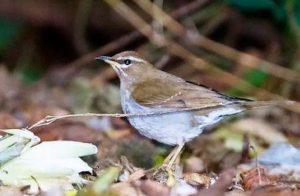Grey-sided Thrush, a globally endangered species of bird has been discovered for the first time in Makwanpur district, making up the total bird species in Nepal to 879.
According to media sources, the Department of National Parks and Wildlife Conservation (DNPWC) under the Ministry of Forests and Soil Conservation in September verified the presence of the new bird species for the first time in Nepal.

This bird species, yet to be given a Nepali name, is 25-centimeter long and was photographed in central Nepal by Som GC, bird conservation officer with Friends of Nature, during one of his bird-watching trips in January last year.
GC has already discovered two other bird species in Nepal—Greater white-fronted goose (Anser albirfrons) and Red-breasted Flycatcher (Ficedula parva).
“The good news from each discovery is that it opens room for other ornithologists and enthusiasts to explore the rich bird diversity that is still left unexplored,” said GC, a professional birder for the last 12 years, adding, “We need adequate funding for research works and monitoring on regular basis.”
Besides Nepal, the Grey-sided Thrush with global population estimated to be between 2,500 and 9,999 has been previously recorded in India, China, Myanmar, Laos and Thailand. This globally threatened bird species listed as vulnerable in the IUCN’s Red List of “Threatened Species” is threatened from the loss of forests.
There have been discoveries of new and extinct bird species in various parts of Nepal by group of birders and professionals in recent times. In June this year, a group of ornithologists, during their bird watching holiday, photographed red-faced liocichla (Liocichla phoenicea)—a species of bird believed to be locally extinct for the first time in 178 years in the forest of Darhakhani Chisapanitar in Upardang Gadi, Chitwan district.
The first-ever assessment of the national conservation status of Nepal’s birds released in March this year found that out of total 878 bird species recorded in Nepal, 167 species are facing severe threats for survival due to problems ranging from habitat loss and degradation to climate change. Various large birds such as birds of prey, storks and pheasants that are found in lowland grassland are the most threatened species followed by wetland birds and tropical and subtropical forest birds.
(Contributed by Tenzing, Siliguri)


